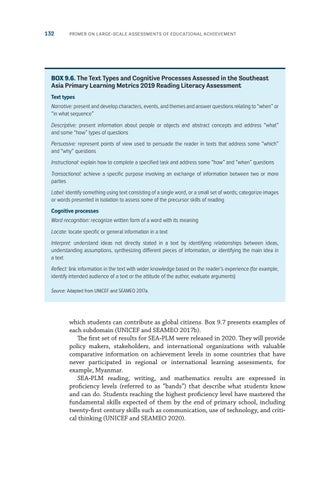132
PRIMER ON LARGE-SCALE ASSESSMENTS OF EDUCATIONAL ACHIEVEMENT
BOX 9.6. The Text Types and Cognitive Processes Assessed in the Southeast Asia Primary Learning Metrics 2019 Reading Literacy Assessment Text types Narrative: present and develop characters, events, and themes and answer questions relating to “when” or “in what sequence” Descriptive: present information about people or objects and abstract concepts and address “what” and some “how” types of questions Persuasive: represent points of view used to persuade the reader in texts that address some “which” and “why” questions Instructional: explain how to complete a specified task and address some “how” and “when” questions Transactional: achieve a specific purpose involving an exchange of information between two or more parties Label: identify something using text consisting of a single word, or a small set of words; categorize images or words presented in isolation to assess some of the precursor skills of reading Cognitive processes Word recognition: recognize written form of a word with its meaning Locate: locate specific or general information in a text Interpret: understand ideas not directly stated in a text by identifying relationships between ideas, understanding assumptions, synthesizing different pieces of information, or identifying the main idea in a text Reflect: link information in the text with wider knowledge based on the reader’s experience (for example, identify intended audience of a text or the attitude of the author, evaluate arguments) Source: Adapted from UNICEF and SEAMEO 2017a.
which students can contribute as global citizens. Box 9.7 presents examples of each subdomain (UNICEF and SEAMEO 2017b). The first set of results for SEA-PLM were released in 2020. They will provide policy makers, stakeholders, and international organizations with valuable comparative information on achievement levels in some countries that have never participated in regional or international learning assessments, for example, Myanmar. SEA-PLM reading, writing, and mathematics results are expressed in proficiency levels (referred to as “bands”) that describe what students know and can do. Students reaching the highest proficiency level have mastered the fundamental skills expected of them by the end of primary school, including twenty-first century skills such as communication, use of technology, and critical thinking (UNICEF and SEAMEO 2020).

